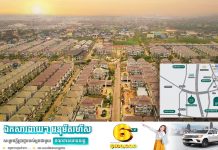By Kong Soriya
In early 2016, experts and developers have expressed concern about being able to reach a stalemate in the real estate sector in Cambodia again and as a shadow of fear that ever happened after the crisis and the global economy in early 2008, but if we examine in-depth and view the truth of evolution in this sector, we can say that the construction sector and real estate in Cambodia is going forward ideally.
If it is based on a number of indicators which features scientific facts, we can draw a conclusion with confidence that this sector will continue to grow, with confidence that the market will become stronger. And we can say that it will have a sustainable development in the future.
In the early half of this year, the ADB has classified Cambodia as “a new tiger economy in Asia” because Cambodia maintained economic growth at 7.7 percent over the past two decades. Meanwhile, the World Bank has also considered Cambodia as a country that evolved from a very low income to low middle-income country – showing that Cambodia is out of the eyes of foreigners who still consider it as “a killing field and crisis era.” But it is an indication to the world that “Cambodia has bigger muscles and is more prosperous than before” as a middle-income country that has more purchasing power and is more attractive for investors than ever before.
The country’s potential lies in maintaining the country’s political stability, strong economic growth, long-term macroeconomic stability, social stability, and legal system. These are attractive to investors who have been looking and have poured the investment capital into the country continuously.
In addition, the force of young people aged 30 to 35 years old – approximately 60 percent – is really strong and have enough energy to fill gaps in the economic and social development areas. Growth of income will cause the growth of purchasing power and increase automatically as investors in the construction and real estate sector download market potential of resources which is also increasing in the country.
Investment capital in the construction sector over the past 9 months of this year rose to $7.56 billion, equivalent to a growth of more than 331 percent from the same period last year.
The huge investment capital really made it clear that investors, domestically and internationally, remain confident in the growth of this sector. And they can profit here continuously. If they do not have confidence and they see that their investment would be at risk, they would not decide to invest billions of dollars in the country.
Raising the question again of whether the sector is facing a crisis or not, the short answer is “not true” because, one, if investors do not see the opportunity, they would not invest hundreds of millions of dollars to build a skyscraper in the country. Two, the increase in average income of the citizens will continue to grow, with the forecast of the Ministry of Finance in Cambodia earlier this year showing that the Cambodian people will have the income per capita of about $1,300 in 2016, and GDP will reach $20 billion. Three, maintaining political stability during various political landscapes has no impact to earnings and economic growth of Cambodia.
Meanwhile, the Ministry of Economy and Finance has also found that real estate projects in Cambodia improved the market where risk for middle-income citizens in the sector has been reduced. The pace of credit also eased as well, also reducing the risk of developing a social and economic crisis.
We should also ask what the real concern is for some analysts and investors in this sector? The answers are all acceptable, we need to look at two aspects — one is that developers and investors are worried about slower sales of condominiums, where this burden has fallen on luxury condo investors who rely on foreign investors.
Slow sales and what is causing it are what we need to study. This problem is not caused by internal affairs in Cambodia. It is caused by external factors. Because developed countries have tightened their regulations to prevent the flow of capital to other countries. This is the real reason that luxury condominium purchasing power decreased.
Although, the culture of Cambodia is still warming up to the idea of living in condominiums, the progress of urbanization, urban factors, demographic and social factors, the economy will force citizens to change their way of thinking about condos for the next 5 to 10 years because they will not find housing affordable in the city. They can be found in the suburbs, but they will take more time and they have to spend more on gasoline.
According to a study by Century21 Cambodia in the first half of the year, it found that the number of condominium supply in the market will grow to nearly 40,000 units in 2020.
Based on the studies of the Ministry of Urban Planning and Construction, citizens living in the city increased by 1 percent per year (population between 160,000 to 2,000,000), and Cambodia needs housing of up to 1 million houses until 2030.
So, investing in condos or any other type of housing still remains the right investment to meet the needs of the country.
Why is this the conclusion? Because condos are located near their work places. Condos also provide comfortable services, sanitation, security, gym, and recreation areas on the roof where they can eat, drink, and chat after work. It also allows a balance lifestyle of work and family.
So, if we base it on the stability of the country, economic growth, and the growth of people’s income, as well as the demographic factors – while the government is preparing a policy to push Cambodia to the country with middle-income level in 2030 – it is a really golden opportunity for investors in construction and real estate, at present and in the future, to seize. It is on the right track as a tiger economy, a huge giant, and an overall healthy economy.



























